Indonesia, Kalimantan: In Search of Wild Orangutans
After setting sail from Singapore, Jeremy and Genevieve Chase on SY Sea Monster head for the Indonesian island of Bali. Along the way they stop off in Kumai, Kalimantan where Jeremy goes in search of wild orangutangs while trying to avoid leeches and tarantulas.
Published 3 years ago
Arriving in Borneo
Since our last update, there have been big changes on SY Sea Monster. We had returned to home during a pandemic, packed up our house, moved aboard, untied the dock lines amid a tearful farewell. We set sail for Indonesia but didn’t get very far. We stopped for work commitments in Batam.
After wrapping up our projects, we cruised SY Sea Monster through the Riau Archipelago meeting village chiefs, swimming in pristine seas and anchoring in unspoiled bays. After our first overnight passage, we arrived in Belitung, once the crown jewel of the Dutch trading empire. We spent a delightful week watching turtles in the bay and exploring the magnificent lighthouse. It was then time to move on again as we continued towards Lombok. We pick up the story on the way from Belitung to Kumai in Borneo.
On to Kumai

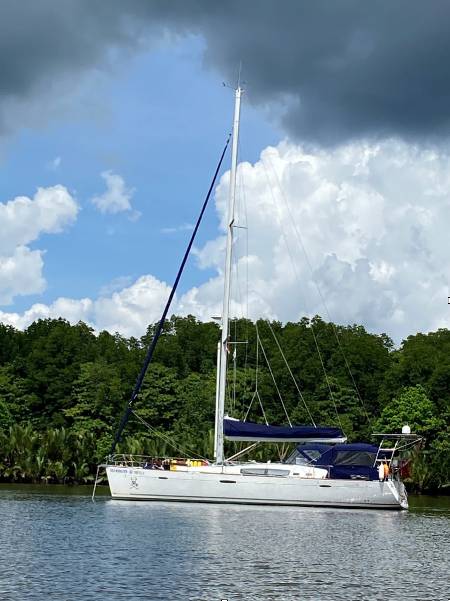
- SY Sea Monster anchored in the jungle river at Kumai.
Kumai is a special place as it is the launching point for the Tanjong Puting National Park and the internationally renowned – Camp Leakey. Camp Leakey is the largest wild orangutang sanctuary in the world.
We sailed the 200nm from Belitong to Kumai over two nights and threaded our way up the river from the ocean. Although the sand spits entering the river were shallow, we followed the way points from our Indonesian cruising guide and found that the path up the river was quite straightforward.
As time had passed, we were nearing the end of Ramadan (the Muslim month of fasting and praying). This is a very quiet period in Indonesia with many holidays, so we had made contact with a local agent ahead of our arrival in order to obtain diesel, find provisions and visit the orangutang sanctuary as efficiently as possible. Majid, the agent, and his family came out to meet us when we arrived and showed us a good place to anchor close to the jungle (2⁰44.33S 111⁰44.07E) and just across from the sleepy dusty main street of downtown Kumai. After some fast negotiation, an orangutang trip was arranged for me on Wednesday. Gen would remain behind on SY Sea Monster as she had work meetings to attend.
Up the river

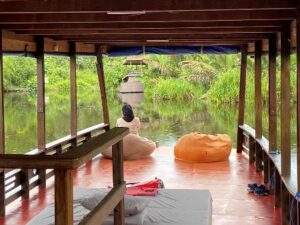
- My klotok with May, the guide, heading upriver looking for monkeys.
On Wednesday, a speed boat came over to collect me and my bag for a short speed boat transfer to a waiting klotok. The klotoks are large wooden boats consisting of two decks. The staff live on the lower deck (on my boat there was a captain, deck crew, chef and English speaking guide) while the guests inhabit the open upper deck. The upper deck of a klotok is furnished variously with a dining table, sofas, bean bags and easy chairs. In the evening, mattresses are brought out and mosquito nets draped over them. Each trip is booked separately so I had a boat to myself.
Once I had been installed aboard, the klotok set off down river towards the entrance of a side river which would take me into the Borneo interior. As soon as the turn is made off the main river, the industrial traffic disappears. The national park is a restricted zone and only licensed captains and boats may journey further up the river.
The milky tea coloured water pours out of the jungle in a continuous stream from upriver. As we slowly wind our way deeper into the Borneo jungle, local saltwater palms give way to pandanis trees which throng on the banks. Still further upriver the pandanis trees disappear and lush green ferns and lilies crowd the banks of the river and the river itself. At times it looks like there will be no way through the mass of vegetation spilling into the river. My guide (May) informs me that before the start of each tourist season, much like sherpas roping the Himalayan peaks, the guides work their way upriver bearing knives and machetes to hack back the jungle vegetation so that the klotoks may pass. Even so, as we progress the trees and plants crowd in on our klotok, the branches often raking down the side of the boat.

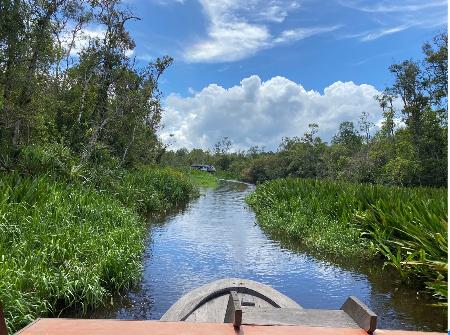
- Will we fit through the gap?
As we move further from civilisation, the jungle also changes. Much of this area had previously been farmed so that the trees are short and immature. In the upper reaches of the river, tall older trees start to form the jungle canopy of a dozen Tarzan movies.

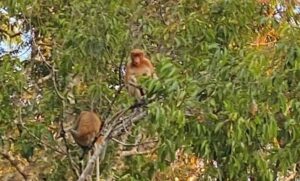
- A probiscis monkey looking down as we pass.
Suddenly we slow at a bend in the river, May points excitedly into the foliage. At first, I can’t see anything but, as I follow the direction she points, I glimpse monkeys sitting in the branches. But these monkeys are different – they have large bulbous noses shaded in a rust colour and comical pot bellies poking out above their waists.
These are probiscus monkeys. In the local dialect, given their unusual features, they are known as “Dutch monkeys” – perhaps an indication of past attitudes to Indonesia’s colonial masters. Probiscus monkeys live in large groups such that it was not long before we saw dozens sitting in the trees.
Progressing further up the river, it becomes apparent that COVID has taken a devastating toll on tourism in this area. At its peak, there could be 70 or 100 klotoks crowding the riverbanks at points of interest. Today, we are a solitary ship on this river. Many of the tour operators have been unable to afford staff wages or to keep their vessels afloat. We pass the husks of not-so-old klotoks which have been beached in the freshwater reeds in the hope they may survive. Unfortunately for the owners, nature quickly reclaims what is her own in these steamy fetid jungles.
Overnight in the jungle
As the day wears on the boat cook serves lunch for one. A meal of local tilapia fish, tempeh, vegetables and, of course, the ubiquitous rice. Tempeh has been an interesting discovery on this trip. It is made of compressed fermented soybeans. Once sliced into slabs, the tempeh is coated in a batter and fried until crispy. It makes an excellent accompaniment to the crisply chilled local Bintang beer. We have taken to keeping tempeh as a staple on SY Sea Monster for impromptu meals.
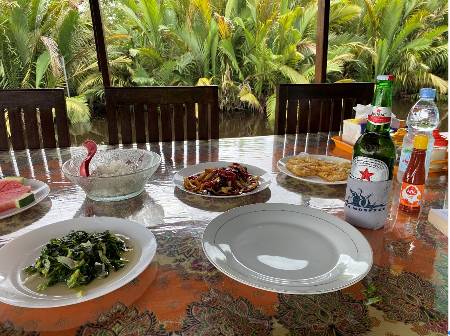
- A local meal of Tilapia fish and Tempeh.
We arrive at our overnight stop, still short of Camp Leakey (which will need to wait until tomorrow). Disembarking, we are one of only three boats at this location. Researchers in Tanjong Puting have established base camps and ranger stations at strategic points. We will go ashore here to visit with the rangers and hear about their work.
As the sun sets, I begin to understand that our sojourn ashore is to be at night. May brightly appears enquiring whether I wish to don my long trousers, hiking boots and knee length socks. I look back at her with a blank face. I don’t have any of those things. I am sailing a yacht around the world – I have my reef shoes, a pair of shorts and a quick dry t-shirt. A glimmer of worry flickers across May’s face before she replies, “don’t worry, the mosquito spray works on leeches too”.
I liberally douse my feet in tropical strength bug repellent, and we set off into the jungle. My fears about leeches are exacerbated when Udi, the park ranger stationed here, pauses to pull on his woollen socks and knee length gum boots.

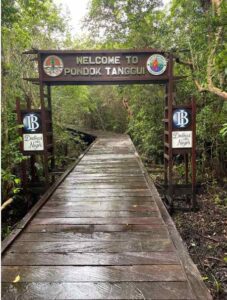
- Udi’s camp entrance.
Setting off into the jungle, behind Udi, I learn of his life story. He tells me that when he was growing up orangutangs were viewed as pests because they would break into houses and steal food (that would explain why the banana store looked like a bank vault). The local people used to shoot them. On the day that his grandfather died, while walking through the forest, Udi and his father saw a wild orangutang. Something in this experience called out to Udi and his fascination with orangutangs was born. Since completing his school, he moved to the National Park and has spent the last 15 years in the Borneo jungle looking after his slice of the orangutang sanctuary.
As Udi tells me about his life, we pass through the moist jungle. The highlight of the trek is not the sleeping birds, which are like puffy tennis balls hanging from tree branches, but “tarantula taunting”. Every now and then we come across a large hole in the ground into which Udi proceeds to poke a long blade of grass. At first it is not apparent why he is doing this. But eventually a large hairy black tarantula the size of a saucer comes rushing out of a hole with its fangs bared. Udi smiles, pleased with his discovery. Trying to impress Udi some jungle knowledge I think back to childhood encyclopedias. “Don’t worry” I say to May, “they don’t bite”. Udi swivels around and promptly corrects me, “They do bite. The bite is more painful than a millipede bite”. Suitably chastened, I shuffle my bare toes further back and leave the gum-booted Udi to carry on teasing the spiders.
Breakfast with Atlas
After returning to the klotok, I inspect every inch of my feet and legs for signs of leeches. With some trepidation I inspect between each of my toes as I had read in the same encyclopedia that this is where leeches often hide out, gorging on blood from their human hosts. Fortunately, there is no sign of any leech infestation.
I take a long hot shower. As I am the only passenger, I feel it is my duty to use as much of the fresh water supply as possible. During my jungle escapade, a mosquito net has appeared over my mattress and, taking the hint, I climb into bed under the sheet. I fall asleep with a cool jungle breeze blowing over me and the sounds of the wild echoing through the night.
There are no curtains on a klotok. When the sun rises, so do I. The indefatigable May has left hot water and strong Indonesian coffee on the table during my slumber. I mix a cup of the rich earthy brew. As I sip on my coffee, the trees around me start to rustle and a troop of macaques appears, making its way upriver. They are entertaining to watch as they leap through the dark green leaves of the trees. It is quite a marvel to see how the monkeys are able to climb trees that look un-climbable and leap across gaps that look un-leapable.
As the flow of the macaques starts to ebb, I spy a shaggy red body in the tree just metres from my breakfast table. I stop chewing mid-mouthful and look more closely. Surely enough, a giant orangutang has arrived. The orangutang sees me and also stops. As it turns towards me, our gazes meet. Immediately I am struck by how human the eyes look. I had heard of this but not expected it to be so true. It is as if I can read the orangutang’s mind. It looks at me, it looks at my breakfast table, it looks at the pile of bananas on the table. It is hungry and wants my bananas.
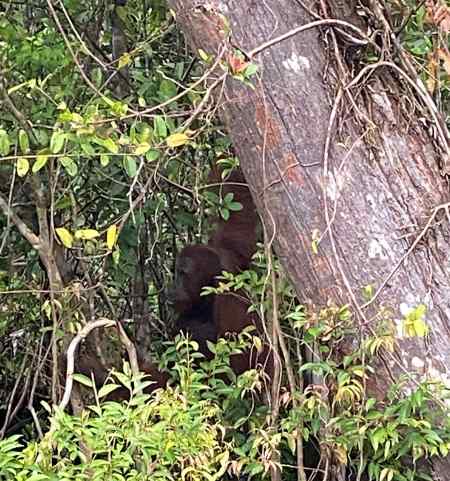
- Atlas making his way through the jungle.
Then as silently as the orangutang has arrived, it moves on. It clambers up onto the jetty to which we and one other boat are tied. The guides, boat captains and cooks all appear with smart phones in hand pointed towards the jetty. I realise that what we are seeing does not form part of the everyday. May whispers to me that this orangutang is called Atlas. He is a male from Camp Leakey (10 nm further up the river) and has not been seen for nearly two years.

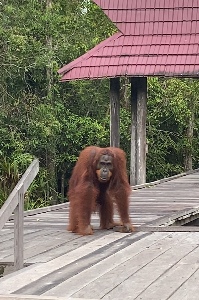
- An angry Atlas.
Atlas is intent on breakfast. With a surprising nimbleness he bounds towards the klotok in front of us. It is clear that Atlas will attempt to board the vessel. The guides and guests dodge out of the way taking cover. The quick-thinking boat captain splashes a pan of hot water at Atlas. Incongruously, the large red ape is put off by the splashing water and backs down. He turns around and glares at all of us. I can read monkey mind again – he is pissed off.
Like a petulant toddler, Atlas huffs off towards the jungle pausing only to glare at us again and wantonly throw an old canoe from the jetty into the river. I am awe-struck. I have just seen a mad monkey. The expression of emotion is so clear and relatable that I start to understand what it means that orangutangs share 97% of their DNA with humans.
On to Camp Leakey
After the Atlas attack, we press on to cover the final 10nm to Camp Leakey. Camp Leakey is located on a smaller secondary river that forks off the river on which we have been travelling. As we round a bend and arrive at the fork, the river turns from chocolatey brown to ink black within a matter of meters. The colour is not caused by pollution, but by the tannins seeping from the vegetation. In essence, we are now cruising up a long deep stream of black tea.
A billed highlight on our Orangutang cruise is the stop at Camp Leakey. Camp Leakey is the oldest orangutang research post on the river and has hosted such celebrities as Bill Clinton and Julia Roberts.
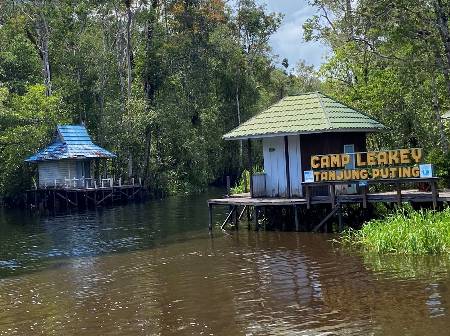
- The fork in the river to reach Camp Leakey.
As we arrive, it is clear that this is a more popular location than other places we have visited. There are 10 klotoks strewn across the river and the raucous sound of people having a good time. After two days of quiet and solitude it is quite confronting. However, the bulk of the visitors today are the local Kumai residents who have come for a day out to celebrate the end of Ramadan. Far from begrudging these guests for having fun, I am encouraged that the townsfolk of Kumai think that the orangutangs are sufficiently special to make a trip to see them. This bodes well for the future preservation of areas like Tanjong Puting.
I joined the flow of people trekking into the jungle to the “feeding station”. Some of the orangutangs living in the area were released after being kept in captivity for extended periods. The rangers provide food for the orangutangs to supplement the diet of fruit and termites available in the jungle. I am not sure that I agree with this. Billie the Bengal turns up for feeding at breakfast time and dinner time and disappears for the rest of the day, and yet, she is a “pet” cat. If the orangutangs turn up for feeding at the same time each day and spend the rest of the time off in the jungle, is there a difference? Are they “pet” orangutangs?
When I voice my concerns, the ranger assures me that there is no guarantee that the orangutangs will turn up on any given day. I don’t know whether to be pleased or alarmed – I have come all this way into the jungle surviving swarms of leeches, taunted tarantulas and an Atlas attack, but I might not see wild orangutangs.
We trek further into the jungle on wet muddy, no doubt leech-infested, paths. Eventually the dark canopy overhead begins to lighten and we have arrived at a clearing. Within the clearing are rows of rough-hewn wooden pews arranged in front of a large wooden platform. Bush pigs grunt and snort in the mud beneath the platform but what has captivated the crowd is a giant orangutang hanging from the slender boughs of a tree above the platform. Next to him is the slender graceful shape of a gibbon. May is once again excited, “The gibbon does not come very often” she informs me.
As feeding time approaches, the crowd grows larger and more impatient. The orangutangs must also anticipate the imminent banana feast as more and more come clambering through the trees. We lose count of the number of shaggy red apes peering down from the trees waiting, like their human counterparts, for the appearance of the rangers and breakfast.
Finally, the rangers appear pushing a wheelbarrow of bananas and carrying huge drums of milk. This is what we have all (monkeys and humans alike) been waiting for. The food offering is placed on the platform and the apes swoop in to eat. We are not disappointed. The interactions between the primates are almost human – comical at times and tender at times. The gibbon entertains us with lightning fast “banana raids” before swinging back up into the trees with his cheeks bulging full of bananas. Leo, the dominant male orangutang, impresses us with his size and ability to shuck bananas from their skins in milliseconds.
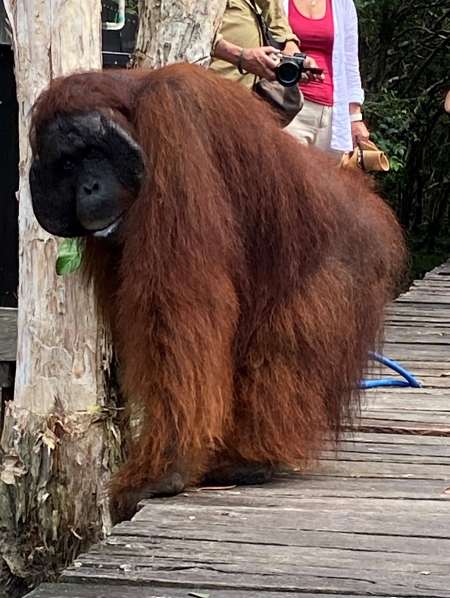
- Leo was a big boy.
Many of the female orangutangs carry infants with them. The crowd chortles when the baby orangutangs are chided by their mothers.
Time to move on

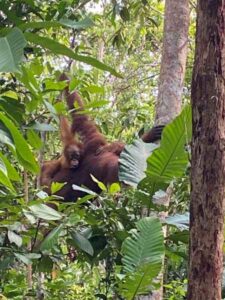
- A baby orangutang hitching a ride through the forest.
Finally, the feeding frenzy slows down. It is time for me to leave. We speed back down the river, carried at a rapid pace downstream. As night falls we approach Kumai town. I reflect on what I have seen these past few days.
The greatest threat to wild orangutangs is habitat destruction. For as long as palm oil production and mining continue in Borneo, it seems that human encroachment on orangutang habitat will continue. However, what is cheering is that the local community has recognised that Tanjong Putting is a special place. There is public support to continue the conservation efforts in the area. This combined with growing public awareness of deforestation issues must help efforts to preserve biodiversity.
For me however, it is once again time to move on. The open sea beckons. Our next destination will be in the less visited islands north of Bali where we will stop at Kangean, a place which has not received tourists for nearly two years.
Jeremy Chase
SY Sea Monster
………………………………………………………………………………………………………………………………………….
About the Authors

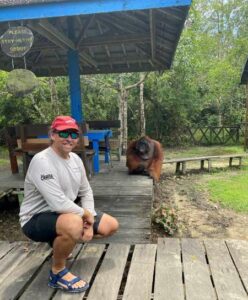
- Jeremy wearing leech-proof shoes with Leo the Orangutang in the background.
Jeremy Chase is a corporate finance lawyer on a career break. He has raced and cruised extensively in Australia, Europe and Asia including completing the gruelling Sydney to Hobart yacht race on five occasions. However, he is yet cross an ocean.
Genevieve Chase is an avid and long-time sailor who has raced and cruised yachts in Australia and Asia. She is also passionate about learning how the mechanical and non-sailing aspects of the boat work. In between sailing, Gen makes use of her PhD in anti-cancer drug research to work full-time as a consultant to start-up pharmaceutical and diagnostic companies.
SY Sea Monster is a 2008 Beneteau Oceanis 50. She is sloop rigged and has two large cabins. After extensive maintenance work in Thailand, she is ready to cruise the World and has entered the 2023 World ARC which she will take part in following a shakedown circumnavigation of Australia.
You can follow SY Sea Monster’s journey at http://sailingbengal.wordpress.com/
………………………………………………………………………………………………………………………………………….
Related Links:
Indonesia, Central Kalimantan: A visit to Kumai and Tanjung Puting in March 2016
Other Reports from SY Sea Monster:
Singapore: Returning to Home Base after a Two-Year COVID Delay
………………………………………………………………………………………………………………………………………….
The opinions expressed in this article are the author’s own and do not reflect the view of Noonsite.com or World Cruising Club.
Related to following destinations: Indonesia, Kumai, North / Central Indonesia - Kalimantan
Related to the following Cruising Resources: Environment, General

Hi Jeremy, Thank you for your visit and telling this Amazing experience visiting Orangutan in Tanjung Puting National Park, Central Borneo. as mentioned the pandemic covid19 caused so much impacted for tourism activities here. lost job, boats (klotok) sank, tourism business totally stop. etc. based on new park regulation post pandemic par visitors allow to book entry park ticket min 3 days before arrival, the park manage visitors qouta in each camp ( Tanjung Harpan station 170 or max 200 visitors, campleaky 180 max 200, and Pondok tangguy 80-100 visitors), visitors also should take min 2 vaccine or booster vaccine . similar to flight regulation. visit here you also could fly to Pangkalanbun airport from Jakarta,semarang and Surbaya. flying from bali should transit in surabaya . once Thank you Jeremy . Hello From Kumai Pangkalanbun. Kalimantan Tengah. wa. +62 082154007172, email : harryyskumai@gmail.com. Harry yacht sevice